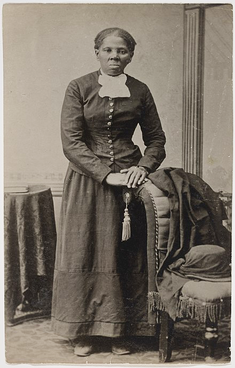Heroes - Lives to Learn From
January
Courage
Physical, Civic, Moral
January
Courage
Physical, Civic, Moral
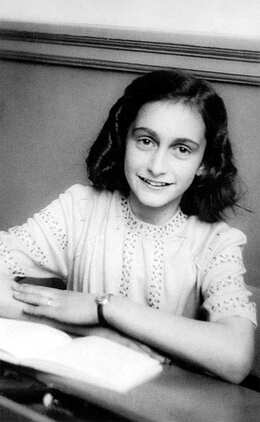
Courage - Anne Frank 1929-1945
Anne Frank, the world-famous example of courage, provided us with one of the most important and powerful testaments to the human spirit in World War II. A Jewish girl in hiding, Anne began to journal after receiving a red-and-white checkered autograph book for her thirteenth birthday, June 12, 1942. Little did she know what those pages would eventually contain: a story of perseverance, courage, and hope through the horrors of Nazi persecution of the Jews.
Anne lived with her father and mother, Otto and Edith, and her older sister, Margot, in Frankfurt, Germany. They moved to Amsterdam when Hitler and the Nazis came to power in Germany, but when Hitler invaded the Netherlands in 1940, their rights were stripped away again. In 1942, Amsterdam Jews were forcibly deported to concentration camps, so the family went into hiding in July with the help of Otto's loyal employees. Other Jewish friends joined them in hiding, and Anne chronicled all their experiences in her diary. In August 1944, the German police stormed their hiding place. Anne, her mother, and her sister were separated from her father Otto, and all three of the Frank women died in the concentration camps (Bergen-Belsen and Auschwitz). Otto Frank survived Auschwitz, and edited and published Anne's diary, known in English as The Diary of a Young Girl, in 1947.
In 1944, the year before her death in the concentration camp, Anne wrote of her ambitions to be a journalist: "I want to go on living even after my death! And that's why I'm so grateful to God for having given me this gift, which I can use to develop myself and to express all that's inside me!" Anne Frank's The Diary of a Young Girl has become a classic firsthand account of the horrors of Nazi occupation from the perspective of an articulate and deeply-feeling child.
Anne Frank, the world-famous example of courage, provided us with one of the most important and powerful testaments to the human spirit in World War II. A Jewish girl in hiding, Anne began to journal after receiving a red-and-white checkered autograph book for her thirteenth birthday, June 12, 1942. Little did she know what those pages would eventually contain: a story of perseverance, courage, and hope through the horrors of Nazi persecution of the Jews.
Anne lived with her father and mother, Otto and Edith, and her older sister, Margot, in Frankfurt, Germany. They moved to Amsterdam when Hitler and the Nazis came to power in Germany, but when Hitler invaded the Netherlands in 1940, their rights were stripped away again. In 1942, Amsterdam Jews were forcibly deported to concentration camps, so the family went into hiding in July with the help of Otto's loyal employees. Other Jewish friends joined them in hiding, and Anne chronicled all their experiences in her diary. In August 1944, the German police stormed their hiding place. Anne, her mother, and her sister were separated from her father Otto, and all three of the Frank women died in the concentration camps (Bergen-Belsen and Auschwitz). Otto Frank survived Auschwitz, and edited and published Anne's diary, known in English as The Diary of a Young Girl, in 1947.
In 1944, the year before her death in the concentration camp, Anne wrote of her ambitions to be a journalist: "I want to go on living even after my death! And that's why I'm so grateful to God for having given me this gift, which I can use to develop myself and to express all that's inside me!" Anne Frank's The Diary of a Young Girl has become a classic firsthand account of the horrors of Nazi occupation from the perspective of an articulate and deeply-feeling child.
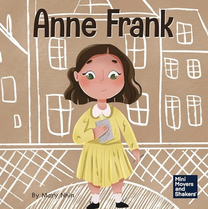
Anne Frank: A Kid's Book About Hope. Mary Nhin. Grow Grit Press, 2021. (K-3)
From the Mini Movers and Shakers series, the story of Anne Frank's life in simple terms appropriate for younger children, but still educational for older children as well. Sweet but diminutive illustrations, however, will mean that older kids probably won't be as interested in this rendition (twelve-to-fifteen-year-old Anne looks a little like a toddler).
From the Mini Movers and Shakers series, the story of Anne Frank's life in simple terms appropriate for younger children, but still educational for older children as well. Sweet but diminutive illustrations, however, will mean that older kids probably won't be as interested in this rendition (twelve-to-fifteen-year-old Anne looks a little like a toddler).
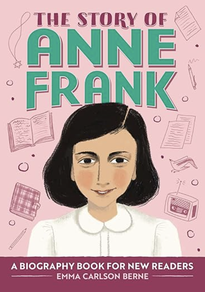
The Story of Anne Frank: A Biography Book for New Readers. Emma Carlson Berne. Rockridge Press, 2021. (1-4)
This clear, thorough story walks children through the details of Anne Frank's life, with helpful diagrams and supplementary materials like a 3-D illustration of the annex where the Franks were in hiding. Winsome illustrations (the truest to the photographs of Anne Frank, among the books that we offer here) and an engaging layout ensure that the reader will learn a lot without getting bored with by the details offered here. A little bit didactic at times (including a quiz and a glossary), but a good choice for beginning readers ready to learn on their own, or small classrooms where the illustrations can be observed as a group.
This clear, thorough story walks children through the details of Anne Frank's life, with helpful diagrams and supplementary materials like a 3-D illustration of the annex where the Franks were in hiding. Winsome illustrations (the truest to the photographs of Anne Frank, among the books that we offer here) and an engaging layout ensure that the reader will learn a lot without getting bored with by the details offered here. A little bit didactic at times (including a quiz and a glossary), but a good choice for beginning readers ready to learn on their own, or small classrooms where the illustrations can be observed as a group.
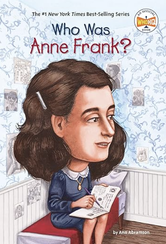
Who Was Anne Frank? Ann Abramson. Illustrated by Nancy Harrison. Penguin Workshop, 2007. (3-6)
Part of the "Who Was" series, this slim chapter book goes in-depth on the story of Anne Frank, including diagrams and maps to help tell her story. Older children will enjoy the additional details about Anne's life before the occupation, the Frank family's relationship with their Jewish heritage, and other information that fits well into a chapter book. Black and white illustrations break up the easy-to-read text, making this a good independent read.
Part of the "Who Was" series, this slim chapter book goes in-depth on the story of Anne Frank, including diagrams and maps to help tell her story. Older children will enjoy the additional details about Anne's life before the occupation, the Frank family's relationship with their Jewish heritage, and other information that fits well into a chapter book. Black and white illustrations break up the easy-to-read text, making this a good independent read.
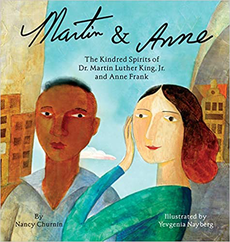
Martin & Anne: The Kindred Spirits of Dr. Martin Luther King, Jr. and Anne Frank. Nancy Churnin. Illustrated by Yevgenia Nayberg. Creston, 2019.
(3-6)
This is an unexpected pair, but Martin Luther King Jr. and Anne Frank--born an ocean apart in the same year (1929)--confronted similar challenges. This lyrically written dual biography shows how each faced the scourge of racism and violence in their own countries with courage, kindness, well chosen words, and a love of humanity. Anne Frank left an inspirational diary published after her death (at age fifteen) in a Nazi concentration camp. Martin Luther King Jr. bequeathed a treasure trove of letters, speeches and the powerful witness of non-violent action before he fell to an assassin's bullet at age 38. Despite their premature deaths, each left a legacy of resistance to bigotry combined with irrepressible hope for the future. This is a gorgeously illustrated, powerful and ultimately hopeful book.
(3-6)
This is an unexpected pair, but Martin Luther King Jr. and Anne Frank--born an ocean apart in the same year (1929)--confronted similar challenges. This lyrically written dual biography shows how each faced the scourge of racism and violence in their own countries with courage, kindness, well chosen words, and a love of humanity. Anne Frank left an inspirational diary published after her death (at age fifteen) in a Nazi concentration camp. Martin Luther King Jr. bequeathed a treasure trove of letters, speeches and the powerful witness of non-violent action before he fell to an assassin's bullet at age 38. Despite their premature deaths, each left a legacy of resistance to bigotry combined with irrepressible hope for the future. This is a gorgeously illustrated, powerful and ultimately hopeful book.
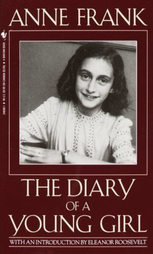
Anne Frank: The Diary of a Young Girl. Bantam Books, 1994 edition. (9-12)
Generally, The Diary of a Young Girl is read at the high school level, though Anne was twelve when she began writing. Teachers may wish to deepen their own understanding by reading this important book.
"A person who's happy will make others happy; a person who has courage and faith will never die in misery!" - Anne Frank, March 7, 1944
Generally, The Diary of a Young Girl is read at the high school level, though Anne was twelve when she began writing. Teachers may wish to deepen their own understanding by reading this important book.
"A person who's happy will make others happy; a person who has courage and faith will never die in misery!" - Anne Frank, March 7, 1944
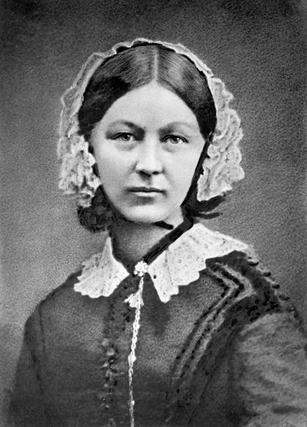
Courage - Florence Nightingale 1820 -1910
The founder of modern nursing, the "lady with the lamp" made the rounds at night among wounded soldiers in the Crimean War (1853-1856). Hers was not simply the courage to tend the wounded in battlefield hospitals. Florence Nightingale also forged a new profession and professional path for women -- one that her parents were none-too-happy about. Born to a wealthy British family who expected her to marry well and bear children, she refused to be circumscribed by privilege or a desire for comfort. Well educated, well traveled, and prayerful, she saw herself called to the service of others. She was inspired by the healing work of Lutheran deaconesses at Kaiserwerth am Rhein, a German hospital, and in 1850 decided to train with them. By 1854, she was on the battlefield in Crimea, working industriously to improve atrocious sanitary and medical conditions for wounded soldiers. One study credits her with reducing the mortality rate of the wounded from 42% to 2%.
During her long and fruitful life, Florence Nightingale ended up remaking -- or making -- the modern profession of nursing. Not only did she serve as battlefield nurse and supervisor of many key organizations, Nightingale had mathematical gifts. She was a prodigious analyzer of data and a prolific writer, who churned out report after report on hygiene, health, and the science of nursing. Many of these she produced from home in bed, because she contracted "Crimean Fever" at age 38, which kept her housebound. Nightingale was responsible for establishing the first professional school of nursing at St. Thomas Hospital in London. She had the courage to follow a call beyond a life of privilege.
Is her life one of courage, compassion, mercy or all of the above? Read some of the wonderful works below and decide for yourself.
The founder of modern nursing, the "lady with the lamp" made the rounds at night among wounded soldiers in the Crimean War (1853-1856). Hers was not simply the courage to tend the wounded in battlefield hospitals. Florence Nightingale also forged a new profession and professional path for women -- one that her parents were none-too-happy about. Born to a wealthy British family who expected her to marry well and bear children, she refused to be circumscribed by privilege or a desire for comfort. Well educated, well traveled, and prayerful, she saw herself called to the service of others. She was inspired by the healing work of Lutheran deaconesses at Kaiserwerth am Rhein, a German hospital, and in 1850 decided to train with them. By 1854, she was on the battlefield in Crimea, working industriously to improve atrocious sanitary and medical conditions for wounded soldiers. One study credits her with reducing the mortality rate of the wounded from 42% to 2%.
During her long and fruitful life, Florence Nightingale ended up remaking -- or making -- the modern profession of nursing. Not only did she serve as battlefield nurse and supervisor of many key organizations, Nightingale had mathematical gifts. She was a prodigious analyzer of data and a prolific writer, who churned out report after report on hygiene, health, and the science of nursing. Many of these she produced from home in bed, because she contracted "Crimean Fever" at age 38, which kept her housebound. Nightingale was responsible for establishing the first professional school of nursing at St. Thomas Hospital in London. She had the courage to follow a call beyond a life of privilege.
Is her life one of courage, compassion, mercy or all of the above? Read some of the wonderful works below and decide for yourself.
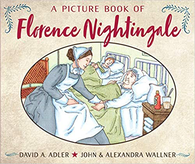
A Picture Book of Florence Nightingale. David A. Adler, Illustrated by John Wallner. Holiday House, 2019. (K-3)
A good basic introduction to Nightingale's life and work. 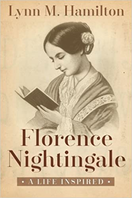
Florence Nightingale: A Life Inspired. Lynn M. Hamilton & Wyatt North.
CreateSpace, 2015. Chapter Book, 130 pages (4-6) An uplifting chapter book biography, highlighting Florence Nightingale's call to serve others, and her relentless determination to improve every aspect of her own contribution to nursing. She was famous for her work in the Crimean War, but analyzed each mistake she made, and worked constantly to improve care, undertaking important work later in India. She did all this battling illness herself. |
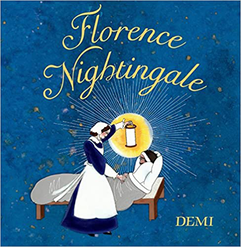
Florence Nightingale. Demi. Henry Holt, 2014 (2-4)
Demi's signature striking illustrations make this book a treasure. Her emphasis is on Nightingale's compassion and courageous determination pursuing an uncharted path. 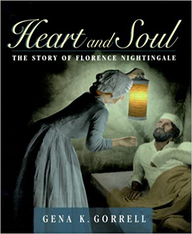
Heart and Soul: The Story of Florence Nightingale. Gena Gorrell.
Tundra Books, 2005. Chapter book (5-8) This highly readable biography weaves Nightingale's remarkable story with the story of her times, and the dreadful state of health care in the nineteenth century. An inspiring portrayal of Florence Nightingale's perspicacity, persistence, and courage, as she pressed for order and cleanliness (not to mention quality medical care) in the midst of war and chaos. An excellent reference for student reports. |
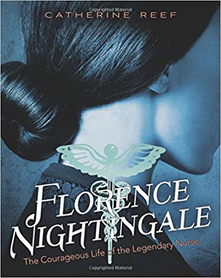
Florence Nightingale. The Courageous Life of the Legendary Nurse. Catherine Reef. Clarion Books, 2016. 192 pgs.(6)
A rich, but easy to read, biographyloaded with pictures and illustrations of the life and times of Florence Nightingale. Called “The Lady with the Lamp” and a “ministering angel”, she devoted herself to caring for the British soldiers during the Crimean War. Always looking for a way to make life better for the sick, she had an enormous effect on the training of nurses and public regard for the field. She defied the Victorian norms and created an amazing body of work by keeping careful statistics of every aspect of health care and making this information available to hospitals and doctors worldwide. Though ill through much of her later life, Florence continued her quest for the betterment of health care until her death at age 90.
A rich, but easy to read, biographyloaded with pictures and illustrations of the life and times of Florence Nightingale. Called “The Lady with the Lamp” and a “ministering angel”, she devoted herself to caring for the British soldiers during the Crimean War. Always looking for a way to make life better for the sick, she had an enormous effect on the training of nurses and public regard for the field. She defied the Victorian norms and created an amazing body of work by keeping careful statistics of every aspect of health care and making this information available to hospitals and doctors worldwide. Though ill through much of her later life, Florence continued her quest for the betterment of health care until her death at age 90.
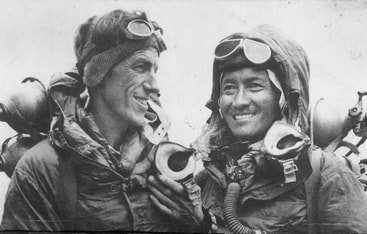
Sir Edmund Hillary (1919-2008) and
Tenzing Norgay (1914-1986)
Exemplars of physical courage and "the spirit of adventure," New Zealand's Edmund Hillary and Sherpa guide Tenzing Norgay were "first to the top" of Mount Everest (the world's highest peak) in 1953. Many thought the summit, which sits five and a half miles above sea level and is blanketed by air so thin human lungs do not abide there, simply could never be taken. Its vertical walls and gaping crevasses served as burial grounds for many a famed climber (George Leigh Mallory among them). But battling howling gales and deadly icefalls, scaling sheer face of rock and ice, and braving thirty below zero temps, Hillary and Norgay summited the peak that had eluded locals, international mountaineers, and National Geographic teams for decades. Indeed, they were part of an extraordinary National Geographic Expedition team that made the ascent possible without a single casualty.
The news of the successful ascent on May 29, 1953 was so stunning that for a time it knocked the coronation of young Queen Elizabeth (same day) from first billing on BBC radio broadcasts! What does it take to do the "never-before-done"? What did a shy New Zealand beekeeper and a smiling Nepalese porter eventually have in common? In this case, rigorous training, teamwork, planning, friendship, and courage. Hillary said the "human spirit of adventure" was for both of them a great motivator. Neither of the two mountaineers forgot to give thanks at the top: Hillary, burying a crucifix there and Norgay (a Buddhist), biscuits and chocolate as offering to the gods. Hillary and Norgay's friendship was life-long, and the proceeds of Hillary's book went to a foundation for development assistance in Nepal. Enkindle courage and inspire the next generation of explorers in your classes with the amazing biographies below.
Tenzing Norgay (1914-1986)
Exemplars of physical courage and "the spirit of adventure," New Zealand's Edmund Hillary and Sherpa guide Tenzing Norgay were "first to the top" of Mount Everest (the world's highest peak) in 1953. Many thought the summit, which sits five and a half miles above sea level and is blanketed by air so thin human lungs do not abide there, simply could never be taken. Its vertical walls and gaping crevasses served as burial grounds for many a famed climber (George Leigh Mallory among them). But battling howling gales and deadly icefalls, scaling sheer face of rock and ice, and braving thirty below zero temps, Hillary and Norgay summited the peak that had eluded locals, international mountaineers, and National Geographic teams for decades. Indeed, they were part of an extraordinary National Geographic Expedition team that made the ascent possible without a single casualty.
The news of the successful ascent on May 29, 1953 was so stunning that for a time it knocked the coronation of young Queen Elizabeth (same day) from first billing on BBC radio broadcasts! What does it take to do the "never-before-done"? What did a shy New Zealand beekeeper and a smiling Nepalese porter eventually have in common? In this case, rigorous training, teamwork, planning, friendship, and courage. Hillary said the "human spirit of adventure" was for both of them a great motivator. Neither of the two mountaineers forgot to give thanks at the top: Hillary, burying a crucifix there and Norgay (a Buddhist), biscuits and chocolate as offering to the gods. Hillary and Norgay's friendship was life-long, and the proceeds of Hillary's book went to a foundation for development assistance in Nepal. Enkindle courage and inspire the next generation of explorers in your classes with the amazing biographies below.
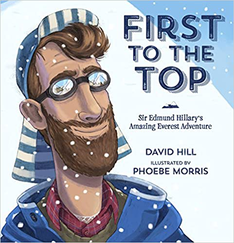
First to the Top. David Hill. Illustrated by Phoebe Morris. Penguin Random House, 2016. (K-3)
Excellent young child's overview of the shy New Zealand child, who followed his heart and grew in confidence and skill. Striking illustrations. Respectful and insightful portrayal of the friendships with Himalayan mountaineers and support teams, and of Hillary's lifelong friendship with Tenzing Norgay. 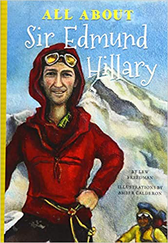
All About Sir Edmund Hillary. Freedman Lew. Illustrated by Amber Calderon and Jennifer Mujezinovic. Blue River Press, 2016. (4-6) 128 pgs.
An quality resource for student reports or deeper student understanding. |
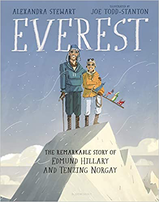
Everest: The Remarkable Story of Edmund Hillary and Tenzing Norgay. Alexandra Stewart. Illustrated by Joe Todd-Stanton. Bloomsbury Children's Books, 2020.
(4-6) At 64 pages this is a lively three-morning read aloud, that will be complete delight for students and teachers. Great presentation of the physical challenges of the journey. 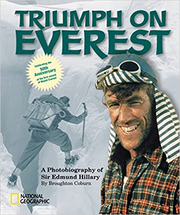
Triumph on Everest: A Photobiography of Sir Edmund Hillary. Broughton Coburn. National Geographic Kids, 2003. (5-6)
Nothing reveals the truth as clearly as photos! Wonderful volume. |
|
Courage - Harriet Tubman 1822-1913
Few people embody physical, civic, and moral courage more fully than Underground Railroad conductor, Harriet Tubman. Born into slavery on a Maryland plantation in 1822, feisty Harriet (born "Araminta" and nicknamed "Minty") endured whippings, beatings, and a skull-fracturing head wound at the hands of abusive plantation owners. She escaped to freedom in 1849, worked as a housekeeper in Philadelphia, but could not forget the enslaved. A deeply religious woman, she decided to do something about their plight, making a total of thirteen very dangerous trips south to lead slaves (including her elderly parents) to freedom in the north, often taking them as far as Canada. "I never ran my train off the track and never lost a passenger," she said. Estimates on the number of slaves she freed run from seventy to three hundred. (Harriet herself claimed the lower figure.) The Civil War found Harriet serving the Union Army first as a nurse for fugitive slaves and then as head of an espionage and scout unit. In the post-war era, she befriended Susan B. Anthony, worked for women's suffrage, and founded a home for the elderly and indigent. Pneumonia claimed her life in 1913. The extraordinary life and deeds of this courageous woman are chronicled in the beautiful books below. |
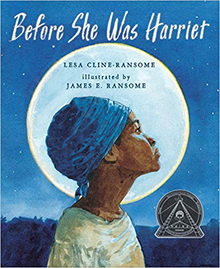
Before She Was Harriet.* Lesa Cline-Ransome.
Illustrated by James E. Ransome. Holiday House, 2017. (K-3) Courage, Service A poetic review of the very full life of Harriet Tubman. Engrossing full-page watercolors draw you into the amazing accomplishments of Harriet’s life - suffragette, nurse, Union spy as well as conductor of the Underground Railroad. The text is sparse, but lyrical and will lead to many questions and discussion of Harriet’s courage and sense of purpose. Excellent with the second grade Core Knowledge unit on the Civil War.*Available on Epic! |
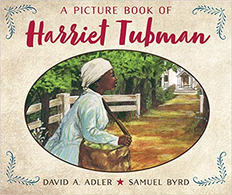
A Picture Book of Harriet Tubman. David Adler.
Illustrated by Samuel Byrd. Holiday, 1992. (1-3) For younger children, a fine, general introduction to the life of the intrepid conductor of the underground railroad. |
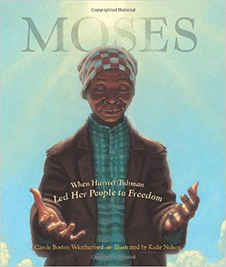
Moses: When Harriet Tubman Led her People to Freedom
Carole Boston Weatherford. Illustrated by Kadir Nelson. Hyperion, 2006. Justice, Lives To Learn From (K-4) A model of faith and courage, Harriet Tubman gazes at the night sky and hears the voice of the Lord, calling her to freedom. Confident of God's faithfulness, she escapes the harsh reality of slavery, and dedicates herself to freeing others. She became for slaves their "Moses," leading them out of oppression on the Underground Railroad. Stark, dramatic, and beautiful illustrations trace this humble woman's journey. |
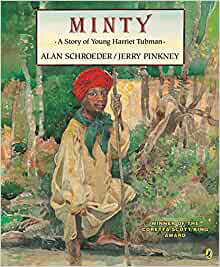
Minty: Story of a Young Harriet Tubman. Alan Schroeder. Illustrated by Jerry Pinkney. Puffin Books, 2000. (2-4)
Schroeder's lively text and Pinkney's richly detailed illustrations make young Harriet leap from the pages. Nicknamed "Minty" as a child (her formal name was Araminta), Harriet was born into slavery, but was a high-spirited girl with a rebellious nature. Eight-year-old Minty frees animals from traps, and tells the story of David and Goliath to her doll. She endures the abuse of plantation owners, dreams of freedom, and listens carefully to her father when he begins to teach her the skills that might make possible her escape. |
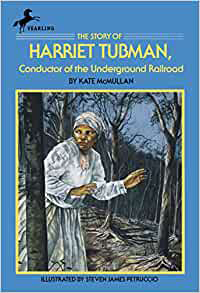
The Story of Harriet Tubman, Conductor of the Underground Railroad. Kate McMullan. Dell Yearling Biography, 1990. (3-6)
At 110 pages, this is a well-written and inspiring read-aloud for upper grades.
At 110 pages, this is a well-written and inspiring read-aloud for upper grades.
Other Courageous Lives
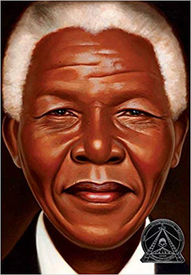
Nelson Mandela. Kadir Nelson. Katherine Tegan Books, 2013.
(1-3) Courage, Love of Country, Sacrifice
Striking illustrations and modest text chart the life of South Africa's first black president. In simple language the book chronicles Mandela's youth, education as a lawyer, active opposition to the system of apartheid (institutionalized racial discrimination), his twenty-seven-year imprisonment for resistance, and finally his release and election as president of post-apartheid South Africa. Nelson Mandela's spirit remained unbroken by his decades in jail, and his work as president focused on building a multi-racial future. Kadir Nelson does not mention Mandela's armed activism against the regime as the offense that landed him in jail, and he missed a good opportunity to speak directly to Mandela's "politics of forgiveness" after his release. The text is general and provides no strong examples of how Mandela led. Still, the illustrations are a triumph and the book does show Mandela as an exemplar of moral courage. For other children's books on Nelson Mandela, see our April "Heroes" section.
(1-3) Courage, Love of Country, Sacrifice
Striking illustrations and modest text chart the life of South Africa's first black president. In simple language the book chronicles Mandela's youth, education as a lawyer, active opposition to the system of apartheid (institutionalized racial discrimination), his twenty-seven-year imprisonment for resistance, and finally his release and election as president of post-apartheid South Africa. Nelson Mandela's spirit remained unbroken by his decades in jail, and his work as president focused on building a multi-racial future. Kadir Nelson does not mention Mandela's armed activism against the regime as the offense that landed him in jail, and he missed a good opportunity to speak directly to Mandela's "politics of forgiveness" after his release. The text is general and provides no strong examples of how Mandela led. Still, the illustrations are a triumph and the book does show Mandela as an exemplar of moral courage. For other children's books on Nelson Mandela, see our April "Heroes" section.
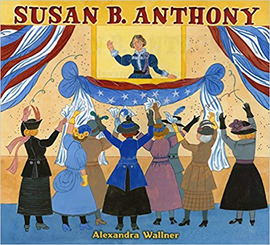
Susan B. Anthony. Alexandra Wallner.
Holiday House, 2012. (2-6) Courage, Love of Country, Justice
A short, but rich introduction to one of America's bravest women. Susan B. Anthony (b. 1820) was an early reader, and her parents believed in education for girls as well as boys. When Susan informed her father that the local school would not teach her Mathematics (only for boys), her father, a mill owner, started a school where boys and girls would learn the same subjects. Susan's life unfolds against that backdrop, as she challenges her father to promote mill girls over men, and goes on to challenge Americans to award the vote to women. She wasn't afraid to stand before a crowd, speak out, and take the eggs thrown at her. She also wasn't afraid to go to jail. Unfortunately, she did not live to see the passage of the 19th Amendment which guaranteed women the right to vote. This short volume contains much information, intriguingly presented and with jewel-like folk art enlivening its pages. A great read-aloud right through sixth grade.
Holiday House, 2012. (2-6) Courage, Love of Country, Justice
A short, but rich introduction to one of America's bravest women. Susan B. Anthony (b. 1820) was an early reader, and her parents believed in education for girls as well as boys. When Susan informed her father that the local school would not teach her Mathematics (only for boys), her father, a mill owner, started a school where boys and girls would learn the same subjects. Susan's life unfolds against that backdrop, as she challenges her father to promote mill girls over men, and goes on to challenge Americans to award the vote to women. She wasn't afraid to stand before a crowd, speak out, and take the eggs thrown at her. She also wasn't afraid to go to jail. Unfortunately, she did not live to see the passage of the 19th Amendment which guaranteed women the right to vote. This short volume contains much information, intriguingly presented and with jewel-like folk art enlivening its pages. A great read-aloud right through sixth grade.
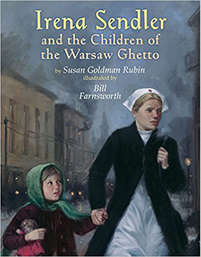
Irena Sendler and the Children of the Warsaw Ghetto. Susan Goldman Rubin. Illustrated by Bill Farnsworth. Holiday House, 2016. (4-6)Courage, Lives to Learn From
An important older child’s book about a Polish Catholic social worker, who over three years smuggled more than 2500 Jewish children out of the Warsaw Ghetto to safety during World War II. Irena Sendler’s actions (combined with the selflessness of Jewish parents who let their children go) ensured that these children did not die in the Treblinka Concentration Camp, as most of their family members did. Irena was eventually apprehended by the Germans for her actions, imprisoned, and tortured. She survived but her thoughts remained with those she couldn’t save. This extraordinary story lay untold for many years, since the Communist regime that ruled Poland after the war considered her (she was anti-communist too) a traitor. The Jewish community remembered, and Irena herself had buried the names of the children she saved in jars in her yard. A haunting and extraordinary story of one woman, who remembered her father’s wisdom: “When someone is drowning, you don’t ask if they can swim. You jump in to save them.” The large picture book format should not be mistaken for a K-3 read. This is an older child’s book.
An important older child’s book about a Polish Catholic social worker, who over three years smuggled more than 2500 Jewish children out of the Warsaw Ghetto to safety during World War II. Irena Sendler’s actions (combined with the selflessness of Jewish parents who let their children go) ensured that these children did not die in the Treblinka Concentration Camp, as most of their family members did. Irena was eventually apprehended by the Germans for her actions, imprisoned, and tortured. She survived but her thoughts remained with those she couldn’t save. This extraordinary story lay untold for many years, since the Communist regime that ruled Poland after the war considered her (she was anti-communist too) a traitor. The Jewish community remembered, and Irena herself had buried the names of the children she saved in jars in her yard. A haunting and extraordinary story of one woman, who remembered her father’s wisdom: “When someone is drowning, you don’t ask if they can swim. You jump in to save them.” The large picture book format should not be mistaken for a K-3 read. This is an older child’s book.
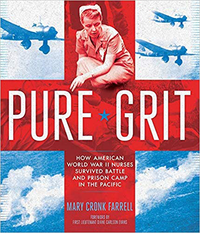
Pure Grit. How American World War II Nurses Survived Battle and Prison Camp in the Pacific. Mary Cronk Farrell. Abrams, 2014. 159 pages. (5-8) Courage, Diligence, Duty
Not a morning read-aloud, this volume is a wonderful collective biography of U.S. Army nurses captured and imprisoned in the Philippines during World War II. These heroic women continued to serve as nurses in prisoner of war camps after their capture, and Mary Cronk Farrell chronicles in rich (but not overwhelming) detail their harrowing experience, accompanied by lots of photos. A Junior Literary Guild Selection, this book reveals a little-known chapter in World War II history, and could be the basis for an older grade student report on the Second World War, and women in the Second World War. One caveat: the book has two significant errors in dates: the headers on pages 68 and 73 indicate May and July of 1941, but the correct date for both is 1942. (The war in the Pacific did not begin until December 1941). This unfortunate error does not negate the value of the book.
Not a morning read-aloud, this volume is a wonderful collective biography of U.S. Army nurses captured and imprisoned in the Philippines during World War II. These heroic women continued to serve as nurses in prisoner of war camps after their capture, and Mary Cronk Farrell chronicles in rich (but not overwhelming) detail their harrowing experience, accompanied by lots of photos. A Junior Literary Guild Selection, this book reveals a little-known chapter in World War II history, and could be the basis for an older grade student report on the Second World War, and women in the Second World War. One caveat: the book has two significant errors in dates: the headers on pages 68 and 73 indicate May and July of 1941, but the correct date for both is 1942. (The war in the Pacific did not begin until December 1941). This unfortunate error does not negate the value of the book.

